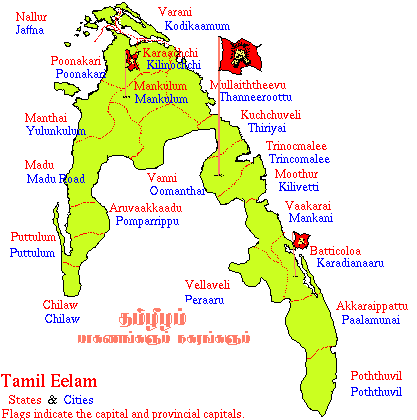Keeping the Peace?
International intervention
by Chandi Sinnathurai
|
Of course, the Tamils want peace. But the question is, peace in whose terms?
|
The time is rapidly running out for the Nordic Monitors (the Sri Lanka Monitoring Mission - SLMM) in Sri Lanka. The Tamil Tigers had been patient with them for quite some time, in spite of the damaged credibility of the SLMM and the deteriorating situation. It is widely believed that, somewhere down the line, the SLMM lost their balance and neutrality and endangered their mission by tending to side with the Government. That in itself would be a serious breach of trust. If true, they would, unfortunately, come to be seen to be lacking in integrity to monitor peace in Sri Lanka.
Efforts have been made to mislead the international community to believe that the Tamils were “up in arms” with the West. That is deliberate propaganda of the Rajapaksha regime.
What the international community would like to see in Sri Lanka is obvious peace. Owing to their own geopolitical interests and a desire for regional stability, the West has been pushing for peace without any separation of the island. It is rumoured that EU-rope would be willing to support “not a two-state solution, but a state within a State.” Reliable information suggests that this peace-plan is mooted by the British Government.
 Nothing, however, is without a “Catch.” The US, EU-rope, Japan and even India would like to ideally see the Tamil Tigers contained or, preferably, fully dismantled. Such operations have repeatedly proved to be futile. The Tigers have the backing of the Tamil masses and the support of the Tamil Diaspora. So Plan B is to woo the Tamil Tigers into peace talks as a way-laying tactic. That has also not worked to plan. Of course, the Tamils want peace. But the question is peace in whose terms? Nothing, however, is without a “Catch.” The US, EU-rope, Japan and even India would like to ideally see the Tamil Tigers contained or, preferably, fully dismantled. Such operations have repeatedly proved to be futile. The Tigers have the backing of the Tamil masses and the support of the Tamil Diaspora. So Plan B is to woo the Tamil Tigers into peace talks as a way-laying tactic. That has also not worked to plan. Of course, the Tamils want peace. But the question is peace in whose terms?
Some are of the view that should Geneva 2 Talks to happen, it would be nothing but be a cosmetic exercise.
There is a real possibility of a full-scale war in Sri Lanka. Already over 420 Tamil civilians have been killed by the State Armed Forces since the Geneva 1 Talks in February 2006.
In all of this wheeling and dealing, the regional super power, India, is believed to increasingly play a dominant role – for the moment, behind the scenes perhaps!
Some Europhiles are suggesting that there is also another possible “positive” (depending on your viewpoint) development in terms of international intervention.
Now what would the exit-strategy of the SLMM be without losing face?
The only recent history of military intervention - that of the Indian Peace Keeping Mission - is not a good parallel and will bring with it haunting memories. That was a psychological nightmare for the Tamils. It was a humiliating defeat for India and for its 4th largest army in the world. It is best never to repeat such a colossal failure.
How to approach the same problem differently? Could it be that EU-rope would be toying seriously with the idea of ‘sending’ a SFOR (Stabilisation Force for Bosnia and Herzogovina) – like operation with the agreement of the Sri Lanka Government and the consent of India?
NATO would say the operation of SFOR had been very successful in Bosnia and Herzegovina, and now with the deepening current crisis in Lebanon, UNIFIL may be strengthened to SFOR's level.
Now what is the mission of the Stabilisation Force? It will ‘deter hostilities and stabilise the peace, contribute to a secure environment by providing a continued military presence in the area of responsibility.’
SFOR also targets and coordinates support to key areas enabling primary civil implementation organisations, and programs towards a lasting consolidation of peace.
How this proposal would be read by Colombo will be interesting to see. What would be the reaction of the Sinhala Buddhist monks and the extremist elements in Sinhala society? In theory, most proposals have had peace “potential.” The ground reality, however, draws a different picture. The important question in this theorem of peace is this: Will such an arrangement bring “lasting consolidation of peace” to Tamils?
This is a question only the Tamils should have the right to respond to.
|  Home
Home Archives
Archives Home
Home Archives
Archives